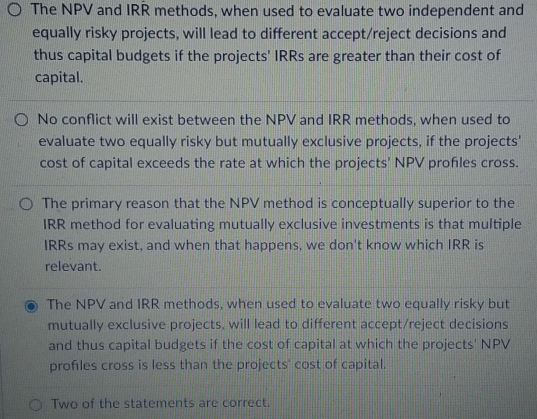O The NPV and IRR methods, when used to evaluate two independent and equally risky projects, will lead to different accept/reject decisions and thus capital budgets if the projects' IRRs are greater than their cost of capital. O No conflict will exist between the NPV and IRR methods, when used to evaluate two equally risky but mutually exclusive projects, if the projects' cost of capital exceeds the rate at which the projects' NPV profiles cross. O The primary reason that the NPV method is conceptually superior to the IRR method for evaluating mutually exclusive investments is that multiple IRRS may exist, and when that happens, we don't know which IRR is relevant. The NPV and IRR methods, when used to evaluate two equally risky but mutually exclusive projects, will lead to different accept/reject decisions and thus capital budgets if the cost of capital at which the projects' NPV profiles cross is less than the projects' cost of capital. OTwo of the statements are correct.
O The NPV and IRR methods, when used to evaluate two independent and equally risky projects, will lead to different accept/reject decisions and thus capital budgets if the projects' IRRs are greater than their cost of capital. O No conflict will exist between the NPV and IRR methods, when used to evaluate two equally risky but mutually exclusive projects, if the projects' cost of capital exceeds the rate at which the projects' NPV profiles cross. O The primary reason that the NPV method is conceptually superior to the IRR method for evaluating mutually exclusive investments is that multiple IRRS may exist, and when that happens, we don't know which IRR is relevant. The NPV and IRR methods, when used to evaluate two equally risky but mutually exclusive projects, will lead to different accept/reject decisions and thus capital budgets if the cost of capital at which the projects' NPV profiles cross is less than the projects' cost of capital. OTwo of the statements are correct.
Intermediate Financial Management (MindTap Course List)
13th Edition
ISBN:9781337395083
Author:Eugene F. Brigham, Phillip R. Daves
Publisher:Eugene F. Brigham, Phillip R. Daves
Chapter12: Capital Budgeting: Decision Criteria
Section: Chapter Questions
Problem 4Q
Related questions
Question
WHICH OF THE FOLLOWING STATEMENT IS CORRECT?

Transcribed Image Text:O The NPV and IRR methods, when used to evaluate two independent and
equally risky projects, will lead to different accept/reject decisions and
thus capital budgets if the projects' IRRs are greater than their cost of
capital.
O No conflict will exist between the NPV and IRR methods, when used to
evaluate two equally risky but mutually exclusive projects, if the projects'
cost of capital exceeds the rate at which the projects' NPV profiles cross.
O The primary reason that the NPV method is conceptually superior to the
IRR method for evaluating mutually exclusive investments is that multiple
IRRS may exist, and when that happens, we don't know which IRR is
relevant.
The NPV and IRR methods, when used to evaluate two equally risky but
mutually exclusive projects, will lead to different accept/reject decisions
and thus capital budgets if the cost of capital at which the projects' NPV
profiles cross is less than the projects' cost of capital.
OTwo of the statements are correct.
Expert Solution
This question has been solved!
Explore an expertly crafted, step-by-step solution for a thorough understanding of key concepts.
This is a popular solution!
Trending now
This is a popular solution!
Step by step
Solved in 3 steps

Knowledge Booster
Learn more about
Need a deep-dive on the concept behind this application? Look no further. Learn more about this topic, finance and related others by exploring similar questions and additional content below.Recommended textbooks for you

Intermediate Financial Management (MindTap Course…
Finance
ISBN:
9781337395083
Author:
Eugene F. Brigham, Phillip R. Daves
Publisher:
Cengage Learning

Managerial Accounting: The Cornerstone of Busines…
Accounting
ISBN:
9781337115773
Author:
Maryanne M. Mowen, Don R. Hansen, Dan L. Heitger
Publisher:
Cengage Learning

Intermediate Financial Management (MindTap Course…
Finance
ISBN:
9781337395083
Author:
Eugene F. Brigham, Phillip R. Daves
Publisher:
Cengage Learning

Managerial Accounting: The Cornerstone of Busines…
Accounting
ISBN:
9781337115773
Author:
Maryanne M. Mowen, Don R. Hansen, Dan L. Heitger
Publisher:
Cengage Learning